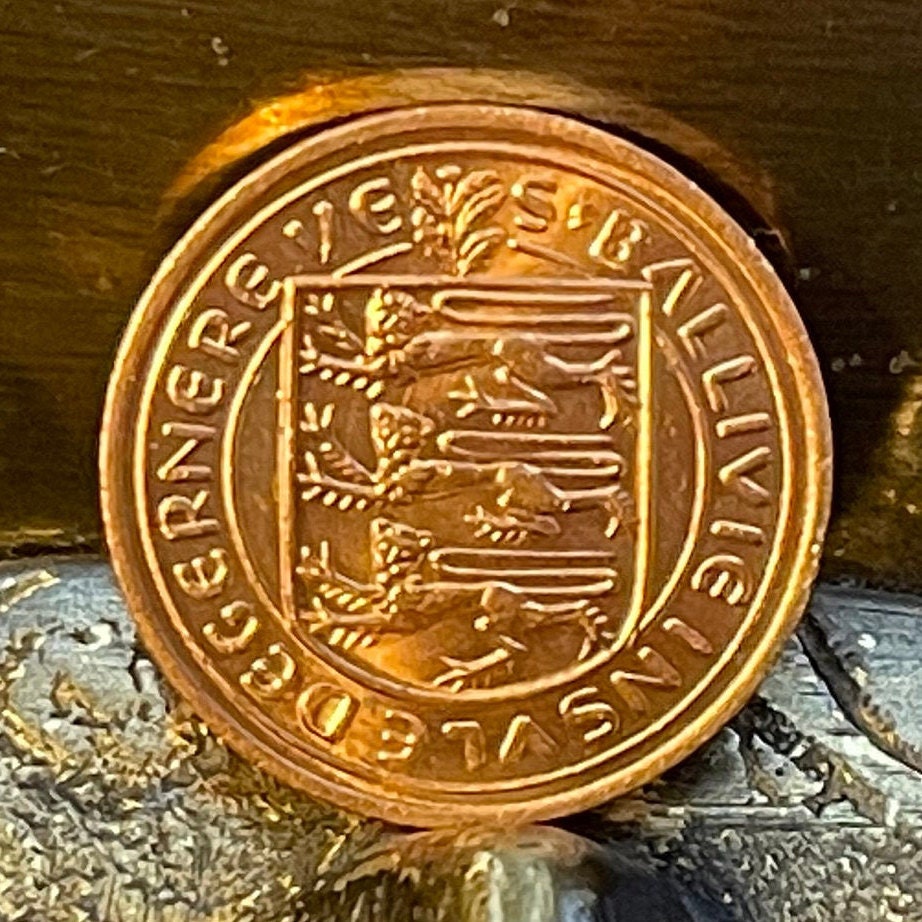elemintalshop
Northern Gannett 1 New Penny Guernsey Authentic Coin Money for Jewelry and Crafts (Seabird)(White Goddess) (Sea Goddess) (3 Leopards) 1971
Northern Gannett 1 New Penny Guernsey Authentic Coin Money for Jewelry and Crafts (Seabird)(White Goddess) (Sea Goddess) (3 Leopards) 1971
Couldn't load pickup availability
Northern Gannett 1 New Penny Guernsey Authentic Coin Money for Jewelry and Craft Making (Seabird)(White Goddess) (Sea Goddess) (3 Leopards) (1971)
Reverse: Northern Gannet (Morus bassanus) in flight, denomination above, date below
Lettering: NEW 1 PENNY
1971
Obverse:Coat of arms--comprised of 3 Luparts, leopards (or lions)
Lettering: S'BALLIVIE INSVLE DE GERNERE VE
Translation: "The Bailiwick of the Island of Guernsey".
Features
Issuer Guernsey
Queen Elizabeth II (1952-date)
Type Standard circulation coin
Year 1971
Value 1 New Penny
0.01 = USD 0.012
Currency Pound (decimalized, 1971-date)
Composition Bronze
Weight 3.56 g
Diameter 20.32 mm
Thickness 1.5 mm
Shape Round
Technique Milled
Orientation Medal alignment ↑↑
Number N# 3465
References KM# 21, Schön# 18
Wikipedia:
The northern gannet (Morus bassanus) is a seabird, the largest species of the gannet family, Sulidae. It is native to the coasts of the Atlantic Ocean, breeding in Western Europe and Northeastern North America. The sexes are similar in appearance. The adult northern gannet has a mainly white streamlined body with a long neck, long and slender wings. It is 87–100 cm (34–39 in) long with a 170–180 cm (67–71 in) wingspan. The head and nape have a buff tinge that is more prominent in breeding season, and the wings are edged with dark brown-black feathers. The long pointed bill is blue-grey, contrasting with black bare skin around the mouth and eyes. Juveniles are mostly grey-brown, becoming increasingly white in the five years it takes them to reach maturity.
In culture
In Homer's Odyssey, the sea goddess Leucothea (Greek: Λευκοθέα "white goddess"), appears "in the likeness of a Gannet" and tells the shipwrecked Odysseus to discard his cloak and raft, instead offering him her veil to wind round himself which will save his life and enable him to reach land. Another early reference to the gannet is in the 7th-century Old English epic poem The Seafarer.
There I heard naught but seething sea,
Ice-cold wave, awhile a song of swan
Then came to charm me gannets' pother
And whimbrels trills for laughter of men,
Kittiwake singing instead of mead.
An old myth from Mykines in the Faroe Islands tells of the giant Tórur seeking mercy following defeat at the hands of Óli, the islanders' head man and magician. In return, he gave them whales, driftwood logs and a bird unique to the archipelago, on condition that the inhabitants did not laugh at his gifts. Over time, the islanders forgot their promise, and lost the whales and logs, but fearful of losing a valuable food source, they never mocked the gannets that Tórur had given them.
Northern gannets have long been eaten for food. Birds, mainly the young, were taken from Bass Rock for at least 350 years until 1885, when the annual cull of about 1,500 individuals finally ceased, and Shetland gannets were sold as "Highland goose" in London restaurants during World War II. Views of the palatability of this bird are mixed, but as well as being a food for the poor it also regularly featured in Scottish royal banquets. In Scotland gannets were traditionally salted to preserve them until they got to market, this technique being replaced by partially cooking or smoking in the era of modern transport. They are normally served roasted, although sometimes raw when pickled or dried.
The best-known site was the remote island of St. Kilda, where adults and eggs were taken in the spring. The fat chicks, known locally as "gugas", were harvested from the precipitous cliffs in August, just before they could fly, and thrown to waiting boats far below. Much of the meat was salted in barrels for storage, but the rest of the bird was also used. Islanders paid their rent in feathers for stuffing pillows and furniture, the gannet stomachs were used to hold oil derived from the carcasses, and the breastbones served as lamp wicks.
Hunting on St. Kilda ceased in 1910, but the gannetry on Sula Sgeir is still exploited under a licence that permits 2,200 chicks to be taken each year. During the hunt, 10 men live on the island, and the cleaned birds are singed on a fire fuelled by their own oil-rich offal. The filleted birds are then taken to Stornoway, where each hunter receives 200 skins to give away or sell. The continuing existence of the practice of hunting and eating gannets attracts criticism in some quarters. The island's name "Sula Sgeir" itself derives from sula, meaning "gannet", and the Old Norse skerr, a skerry. Other sites that continued hunting into the 20th century were Eldey in Iceland, where the activity ceased in 1939, and Mykines, where small-scale culling still persists. About 500 young are culled for consumption each year in Mykines, using techniques similar to those of the Sula Sgeir hunts.
Although the Bass Rock population fell to fewer than 4,000 pairs in the early 19th century, the population soon recovered once hunting ceased, and St. Kilda was harvested sustainably for hundreds of years. Elsewhere, the recovery was less complete. The Bird Rocks colony in the Gulf of St Lawrence may once have held 250,000 birds, but unchecked hunting, including for fish bait, meant that the population was only 1,000 birds by 1932, despite government protection since 1904.
*********
Answers.com:
S'BALLIVIE INSVLE DEGERNERE VE is the inscription on most Bailiwick of Guernsey coins from about 1956 to 1984. As close as I can find to a resonable translation is "The Bailiwick of the Island of Guernsey". A Bailiwick is the jurisdiction of a Bailiff. The expression seems to derive from one of the old languages spoken on Guernsey, Guernesiais (Guernsey Norman), Sercquiais (Sark-French), or Auregnais (Norman dialect of Alderney) which is no longer spoken. https://www.answers.com/Q/What_does_s%27ballivie_insvle_degernereve_mean
Share










As described! In good condition.









